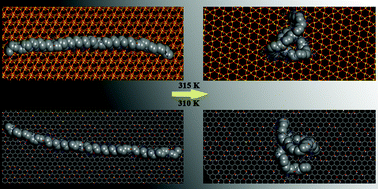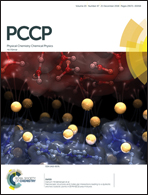Molecular dynamics study of coil-to-globule transition in a thermo-responsive oligomer bound to various surfaces: hydrophilic surfaces stabilize the coil form†
Abstract
The structural and dynamical properties of 40-mer of thermo-responsive polymer PNIPAM covalently bound to different surfaces have been studied, at different temperatures, by means of molecular dynamics simulations. Evolution of the radius of gyration, Rg, of the polymer chain and radial distribution functions (RDFs) calculated for the carbon atoms of the PNIPAM backbone with water oxygens and for the hydrogen atom of the amide groups with water oxygens indicate that functionalized surfaces affect the coil-to-globule transition of PNIPAM, by means of electrostatic interactions, increasing the lower critical solution temperature (LCST) of the polymer. Such interactions, mainly represented by a H-bond, hinder the transition in the globular form while hydrophobic groups on the surface, such as –OCH3, contribute to the globular collapse. A significant alteration in the arrangement of water molecules around the polymer is testified by: (i) the absence of the second peak in the RDF between the C atoms of the PNIPAM backbone and the O atoms of water at the same temperature at which the radius of gyration decreases; (ii) the height of both the first and the second peak of the RDF between the H atom of the amide groups and water O atoms decreases when the temperature increases above the LCST. Finally, the H-bond autocorrelation function indicates that: (i) hydrogen bonds between the bound-to-surface PNIPAM acceptor groups (O![[double bond, length as m-dash]](https://www.rsc.org/images/entities/char_e001.gif) C
C![[double bond splayed right]](https://www.rsc.org/images/entities/char_e00a.gif) ) and the H atoms of water molecules are less persistent than H-bonds formed between the free PNIPAM acceptor groups and water; (ii) H-bonds between the PNIPAM acceptor groups and hydroxyl groups on the quartz surface are longer lived than those formed on graphene oxide.
) and the H atoms of water molecules are less persistent than H-bonds formed between the free PNIPAM acceptor groups and water; (ii) H-bonds between the PNIPAM acceptor groups and hydroxyl groups on the quartz surface are longer lived than those formed on graphene oxide.



 Please wait while we load your content...
Please wait while we load your content...